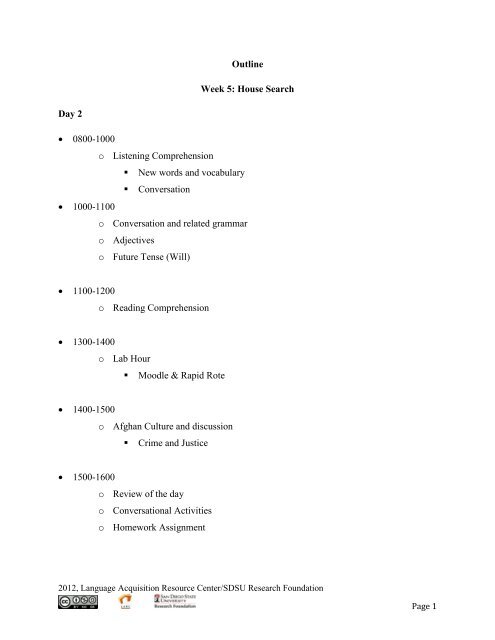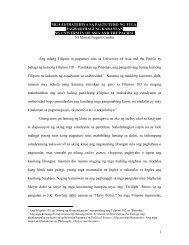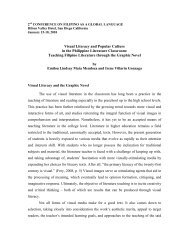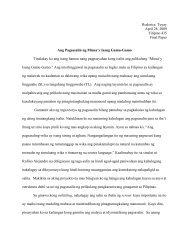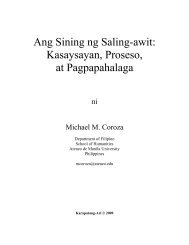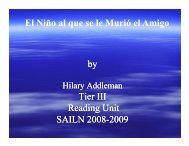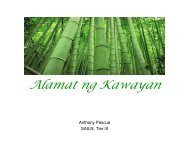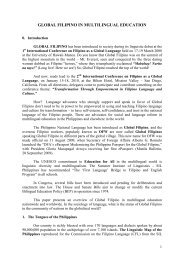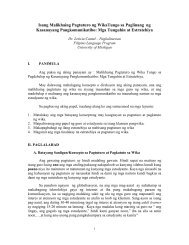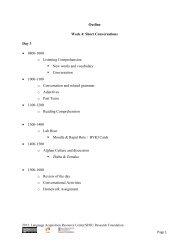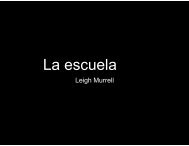Outline Week 5 - Language Acquisition Resource Center
Outline Week 5 - Language Acquisition Resource Center
Outline Week 5 - Language Acquisition Resource Center
- No tags were found...
Create successful ePaper yourself
Turn your PDF publications into a flip-book with our unique Google optimized e-Paper software.
<strong>Outline</strong><br />
<strong>Week</strong> 5: House Search<br />
Day 2<br />
0800-1000<br />
o Listening Comprehension<br />
• New words and vocabulary<br />
• Conversation<br />
1000-1100<br />
o Conversation and related grammar<br />
o Adjectives<br />
o Future Tense (Will)<br />
1100-1200<br />
o Reading Comprehension<br />
1300-1400<br />
o Lab Hour<br />
• Moodle & Rapid Rote<br />
1400-1500<br />
o Afghan Culture and discussion<br />
• Crime and Justice<br />
1500-1600<br />
o Review of the day<br />
o Conversational Activities<br />
o Homework Assignment<br />
2012, <strong>Language</strong> <strong>Acquisition</strong> <strong>Resource</strong> <strong>Center</strong>/SDSU Research Foundation<br />
Page 1
House Searching<br />
Vocabulary and Conversation Lesson Plan<br />
<strong>Week</strong> -5, Day – 2<br />
Part I<br />
DATE:<br />
Duration: 1 hour<br />
From: 0800 – 0900<br />
LEVEL: Elementary<br />
LANGUAGE: Dari<br />
FUNCTIONAL OBJECTIVE(s):<br />
By the end of this lesson, participants will be able to:<br />
Learn the new vocabulary and phrases, and<br />
Get engaged in short conversations<br />
REQUIRED MATERIALS:<br />
Classroom with whiteboard and markers<br />
Computer with internet connection<br />
Handouts<br />
Flashcards<br />
STEP ONE: SETTING THE STAGE<br />
In this stage, instructor introduces the lesson indirectly.<br />
STANDARD(S)<br />
USED<br />
ACTIVITY 1: (10 minutes)<br />
Quiz: Instructor administers a vocabulary quiz to check students’<br />
retention about previous lesson and also to relate today’s lesson to the<br />
previous one: Reference 2.1.1.<br />
STEP TWO: COMPREHENSIBLE INPUT<br />
In this stage instructor begins the instruction.<br />
ACTIVITY 1: Time :(10 minutes)<br />
1. Audio: Instructors plays an audio and asks students to listen and try to<br />
comprehend the main idea (Reference 2.1.2)<br />
2. Instructor checks students’ comprehension by asking simple questions<br />
3. Instructor model the lesson in multiple ways to offer more<br />
comprehension to students<br />
ACTIVITY 2: Time :(25 minutes)<br />
1. PPT. Instructor uses slides to better introduces today’s vocabulary:<br />
Reference 2.1.3<br />
2. Instructor provides students with vocabulary handout: Reference 2.1.4<br />
(If students have already received the handout as homework there will be<br />
ST. 1.2<br />
STANDARD(S)<br />
USED<br />
ST. 1.2 & 1.1<br />
ST. 1.3 & 1.1<br />
2012, <strong>Language</strong> <strong>Acquisition</strong> <strong>Resource</strong> <strong>Center</strong>/SDSU Research Foundation<br />
Page 2
no need to provide them with a duplicate)<br />
CUTLURAL ASPECT<br />
Instructor explains any cultural point attached to the word(s). ST. 2.1 & 2.2<br />
STEP THREE: GUIDED PRACTICE<br />
ACTIVITY 1: Time 5 minutes<br />
• Matching Activity: Students work on a matching activity:<br />
Reference 2.1.5<br />
• Instructor provides feedback<br />
Formative Assessment: Students read their answers and instructor<br />
provides feedback<br />
Fly Swatter Game: If time permitted, students will be divided into two<br />
groups and play the game.<br />
Instructor provides clear instruction about the game.<br />
One instructor will write as many words as possible on the board and<br />
call on each team to swat the word as soon as he or she hears it.<br />
Second instructor will take care of the points<br />
STANDARD(S)<br />
USED<br />
ST. 1.2<br />
ST. 1.1 & 1.2<br />
2012, <strong>Language</strong> <strong>Acquisition</strong> <strong>Resource</strong> <strong>Center</strong>/SDSU Research Foundation<br />
Page 3
Part II<br />
<strong>Week</strong> -5, Day – 2<br />
STEP THREE: GUIDED PRACTICE<br />
ACTIVITY 1: Time: 15 minutes<br />
Flashcards: Students work with partner and reinforce learning of<br />
vocabulary by using flashcards. Students practice this activity in the form<br />
of a conversation with each other. For example: if the cards says “wodah-ray<br />
zha” say: daa Stop dai (this is Stop-referring to the card).<br />
Students switch their roles and practice more.<br />
ACTIVITY 2: Time: 8-10 minutes<br />
One-on-One Mentoring with instructors: While other students<br />
work on other activities, each student spends 8-10 minutes with an<br />
instructor and practices the language in the form of a short conversation<br />
(OPI)<br />
STEP THREE: INDEPENDENT PRACTICE<br />
ACTIVITY 1: Time: 15 minutes<br />
Pair work: Students work with partners and create a conversation based<br />
on the theme of the week and contents learned so far.<br />
STEP FIVE: ASSESSMENT AND EVALUATION<br />
ASSESSMENT: Time: 10 minutes<br />
With a different partner, students present their skits as commands in front<br />
of the class<br />
STANDARD(S)<br />
USED<br />
ST. 1.2 & 1.1<br />
ST. 1.1<br />
ST. 1.1<br />
STANDARD(S)<br />
USED<br />
ST. 1.1 & 1.3<br />
2012, <strong>Language</strong> <strong>Acquisition</strong> <strong>Resource</strong> <strong>Center</strong>/SDSU Research Foundation<br />
Page 4
Activity<br />
0800-1000<br />
2012, <strong>Language</strong> <strong>Acquisition</strong> <strong>Resource</strong> <strong>Center</strong>/SDSU Research Foundation<br />
Page 5
Reference 2.1.1:<br />
Review Please write the English meaning for the following words: (10 Points)<br />
English<br />
دری<br />
۱ یکطرف<br />
۲ قوا<br />
۳ امنیت<br />
۴ تالیش )کردن(<br />
۵ دروازه<br />
۶ ابز )کردن(<br />
۷ درست است<br />
۸ اعضای فامیل<br />
۹ پدر<br />
۱۱ ااتق<br />
2012, <strong>Language</strong> <strong>Acquisition</strong> <strong>Resource</strong> <strong>Center</strong>/SDSU Research Foundation<br />
Page 6
Reference 2.1.2: Audio (Instructor’s copy)<br />
Please listen to the audio and try to understand the main idea of it<br />
امروز هوا<br />
چطور است؟<br />
a امروز هوا چطور است؟<br />
امروز هوا<br />
بسیار خوب<br />
تابستان، خزان و زمستان.<br />
باشد . می<br />
است.<br />
کابل چهار<br />
تابستان<br />
فصل<br />
گرم و زمستان<br />
بهار، یعنی دارد<br />
معمولا سرد<br />
b<br />
هوا در اکبل فردا چطور خواهد بود ؟<br />
a<br />
فردا قبل از ظهر صاف و بعد از ظهر برالود خواهد بود،<br />
اماکن<br />
دارد که ابران ببارد<br />
. b<br />
Reference 1.1.3: Power Point Presentation (Vocabulary)<br />
2012, <strong>Language</strong> <strong>Acquisition</strong> <strong>Resource</strong> <strong>Center</strong>/SDSU Research Foundation<br />
Page 7
Reference 2.1.4: Vocabulary Handout<br />
English<br />
Transliteration<br />
دری<br />
Today Em-roz<br />
۱ امروز<br />
Weather Ha-waa<br />
۲ هوا<br />
Usually Ma-moo-lan<br />
۳ معمولا Season Fa-sel<br />
۴ فصل<br />
Such as / For example Ya-nay<br />
۵ یعین<br />
Spring Ba-haar<br />
۶ هبار<br />
Summer Taa-bes-taan<br />
۷ اتبس تان<br />
Fall/autumn Kha-zaan<br />
۸ خزان<br />
Winter Ze-mes-taan<br />
۹ زمس تان<br />
Warm garm<br />
۱۱ گرم<br />
Cold sard<br />
۱۱ رسد<br />
Tomorrow Far-daa<br />
۱۲ فردا<br />
Will (future) Khoaa___<br />
۱۳ خواه<br />
Before Qa-bel<br />
۱۴ قبل<br />
After Ba’d<br />
۱۵ بعد<br />
Noon Zu-hur<br />
۱۶ ظهر<br />
Clear / blue sky Saaf<br />
۱۷ صاف<br />
Cloudy a-ber aa-lood<br />
۱۸ ابرآ لود<br />
Possibility Em-kaan<br />
۱۹ اماکن<br />
2012, <strong>Language</strong> <strong>Acquisition</strong> <strong>Resource</strong> <strong>Center</strong>/SDSU Research Foundation<br />
Page 8
Reference 2.1.5: Matching Activity: Please match the following words to their equivalent in the<br />
next column:<br />
English<br />
دری<br />
Fall/autumn<br />
۱ امروز<br />
Tomorrow<br />
۲ هوا<br />
۳ معمولا Cold<br />
After<br />
۴ فصل<br />
Today<br />
۵ یعین<br />
Summer<br />
۶ هبار<br />
Weather<br />
۷ اتبس تان<br />
Usually<br />
۸ خزان<br />
Sister<br />
۹ زمس تان<br />
Such as<br />
۱۱ گرم<br />
Spring<br />
۱۱ رسد<br />
Warm<br />
۱۲ فردا<br />
Winter<br />
۱۳ خواهر<br />
Season<br />
۱۴ قبل<br />
Reference 2.1.6: Flashcards: Students will use the cards that they have already made for this<br />
activity<br />
2012, <strong>Language</strong> <strong>Acquisition</strong> <strong>Resource</strong> <strong>Center</strong>/SDSU Research Foundation<br />
Page 9
Dari Grammar<br />
Lesson Plan<br />
<strong>Week</strong> -5, Day -2<br />
DATE<br />
Duration: 1 hour<br />
From: 1000 - 1100<br />
LEVEL: Elementary<br />
LANGUAGE: Dari<br />
FUNCTUNAL OBJECTIVE(s):<br />
By the end of this lesson, participants will be able to Learn:<br />
Adjective<br />
Simple future Tense<br />
Use them in their conversations<br />
REQUIRED MATERIALS:<br />
Classroom with whiteboard and markers<br />
Computer with internet connection<br />
Dari textbook /handout<br />
STEP ONE: SETTING THE STAGE<br />
Instructor introduces the new topic to participants indirectly.<br />
ACTIVITY 1: (5 minutes)<br />
In this stage an instructor answers students’ questions about previous<br />
lessons.<br />
Instructor briefly talks about weather in future tense<br />
STEP TWO: COMPREHENSIBLE INPUT<br />
Instructor begins the lesson.<br />
ACTIVITY 2: Time :(15 minutes)<br />
PPT.: Introduces the verb Simple Future Tense and adjective:<br />
Reference 5.2.1. Instructor practices the pronunciation of words with<br />
students individually and in groups<br />
STEP THREE: GUIDED PRACTICE and Evaluation<br />
ACTIVITY 1: Time 30 minutes<br />
Students will be divided into two groups and will practice time, the verb<br />
can and Action Verbs with an instructor in the form of phrases and<br />
complete sentences.<br />
STANDARD(S)<br />
USED<br />
ST 1.1<br />
STANDARD(S)<br />
USED<br />
ST. 1.3 & 1.1<br />
STANDARD(S)<br />
USED<br />
ST.1.1<br />
2012, <strong>Language</strong> <strong>Acquisition</strong> <strong>Resource</strong> <strong>Center</strong>/SDSU Research Foundation<br />
Page 10
For example:<br />
Instructor: how is the weather today?<br />
Student: answers<br />
Instructor: How will be the weather tomorrow?<br />
Student: student answers<br />
2012, <strong>Language</strong> <strong>Acquisition</strong> <strong>Resource</strong> <strong>Center</strong>/SDSU Research Foundation<br />
Page 11
Activities<br />
1000-1100<br />
2012, <strong>Language</strong> <strong>Acquisition</strong> <strong>Resource</strong> <strong>Center</strong>/SDSU Research Foundation<br />
Page 12
Simple Future tense<br />
The future tense is formed by using the Present Tense of ( خواستن = خواه ) “wish/will,” without<br />
verb: ), followed by the Past Stem of the می)<br />
Simple Future tense<br />
:(بود) c. The future tense of tobe very is<br />
Future Future Future Present<br />
I will be<br />
من اس مت I am من خوامه بود<br />
You will be<br />
We will be<br />
He/she will be<br />
They will<br />
شام خواهید بود<br />
You are شام استید ما خواهمی بود<br />
We are ما استمی او خواهد بود<br />
He/she is او است They are آهنا خواهند بود<br />
آ هنا استند Reading Comprehension<br />
Lesson Plan<br />
<strong>Week</strong> -5, Day –2<br />
DATE:<br />
Duration: 50 minutes<br />
From: 1100-1200<br />
LEVEL: Elementary<br />
LANGUAGE: Dari<br />
Functional OBJECTIVE(s):<br />
By the end of this lesson, participants will be able to:<br />
2012, <strong>Language</strong> <strong>Acquisition</strong> <strong>Resource</strong> <strong>Center</strong>/SDSU Research Foundation<br />
Page 13
Read from Dari script and<br />
Comprehend the main idea of the text<br />
Improve their awareness about Afghan culture.<br />
REQUIRED MATERIALS:<br />
Classroom with whiteboard and markers<br />
Reading handouts<br />
STEP ONE: SETTING THE STAGE<br />
In this stage, instructor introduces the lesson indirectly.<br />
STEP TWO: COMPREHENSIBLE INPU<br />
ACTIVITY 1: Time :(10 minutes)<br />
<br />
Instructor offers some background information about the content of the<br />
text and introduces some key words<br />
STANDARD(S)<br />
USED<br />
STANDARD(S)<br />
USED<br />
ST. 1.3<br />
STEP THREE: GUIDED PRACTICE<br />
ACTIVITY 1: Time: 20 minutes<br />
Pair Activity: Students work with partners and read the text. The<br />
text is in the form of a dialogue. Each student takes a role, reads his or<br />
her part, and then switches roles for more practices: Reference: 2.3.1<br />
STEP THREE: INDEPENDENT PRACTICE<br />
ACTIVITY 1: Time: 10 minutes<br />
Students work independently and read the text for greater detail<br />
STEP FIVE: ASSESSMENT AND EVALUATION<br />
Students take turns and read the text<br />
STANDARD(S)<br />
USED<br />
ST. 1.2<br />
ST. 1.2<br />
STANDARD(S)<br />
USED<br />
2012, <strong>Language</strong> <strong>Acquisition</strong> <strong>Resource</strong> <strong>Center</strong>/SDSU Research Foundation<br />
Page 14
Activities<br />
1100-1200<br />
2012, <strong>Language</strong> <strong>Acquisition</strong> <strong>Resource</strong> <strong>Center</strong>/SDSU Research Foundation<br />
Page 15
Reference: 2.3.1<br />
Reading<br />
امروز هوا چطور است؟<br />
a است؟ چطور هوا در اکبل امروز<br />
b<br />
امروز هوا بس یار<br />
زمس تان. اتبس تان<br />
خوب<br />
گرم<br />
است. اکبل<br />
و زمس تان<br />
معو ال<br />
معمو ال<br />
چار<br />
رسد<br />
دارد.<br />
فصل ابشد<br />
می هبار، اتبس تان، خزان<br />
و<br />
.<br />
a ؟ بود خواهد چطور فردا اکبل هوا<br />
از قبل فردا<br />
ظهر صاف و بعد از ظهر ابرآلود<br />
ببارد. ابران که دارد اماکن بود، خواهد<br />
b<br />
Comprehensive Question:<br />
1. How is the weather today? Ans: ______________________________<br />
2. How many seasons does Kabul have? Ans: _____________________<br />
3. Will it rain in Kabul tomorrow? Ans: _________________________<br />
2012, <strong>Language</strong> <strong>Acquisition</strong> <strong>Resource</strong> <strong>Center</strong>/SDSU Research Foundation<br />
Page 16
Lab Hour<br />
Lesson Plan<br />
<strong>Week</strong> -5, Day -2<br />
DATE:<br />
Duration: 1 hour<br />
From: 1300-1400<br />
LEVEL: Elementary<br />
LANGUAGE: Dari<br />
Functional OBJECTIVE(s):<br />
By the end of this lesson students will be able to:<br />
Practice better the new vocabulary and feel more comfortable reading<br />
Dari text<br />
REQUIRED MATERIALS:<br />
Computer and internet connection<br />
Moodle – Storyline: Dari Text<br />
Rapid Rote<br />
STEP ONE: SETTING THE STAGE<br />
ACTIVITY 1: (5 minutes)<br />
Students will review last day’s words first<br />
STEP TWO: Guided Practice and Assessment<br />
ACTIVITY 1: Time: (35 minutes)<br />
1. Moodle: Students login to their Moodle account and attend the online<br />
lesson “WK5-D2”<br />
STANDARD(S)<br />
USED<br />
ST. 1.2<br />
STANDARD(S)<br />
USED<br />
ST. 1.2<br />
2. Rapid Rote: Students will practice the vocabulary using Rapid Rote<br />
3. Moodle: Students will return to Moodle to take a quiz.<br />
<br />
One-on-One Mentoring: While students continue to work on their<br />
cards, other instructors will meet with each student individually for at<br />
least 7 - 10 minutes for one-on-one mentoring. During this session<br />
students will closely interact with instructors and have a better chance to<br />
get their questions answered.<br />
ST.1.1<br />
2012, <strong>Language</strong> <strong>Acquisition</strong> <strong>Resource</strong> <strong>Center</strong>/SDSU Research Foundation<br />
Page 17
Afghan Culture<br />
Crime and Justice<br />
<strong>Week</strong> 5– Day 2<br />
DATE:<br />
Duration: 1 Hour<br />
1400-1500<br />
LEVEL: Beginner<br />
LANGUAGE: English<br />
FUNCTIONAL OBJECTIVE(s):<br />
By the end of this lesson, participants will be able to:<br />
Learn about crime and justice in Afghanistan<br />
Apply their knowledge in the context of Afghan culture<br />
REQUIRED MATERIALS & RESOURCES:<br />
Computer with internet connection: www.Pashtuculture.com Lesson 13<br />
Projector with connectors<br />
Whiteboard and makers<br />
STEP ONE: SETTING THE STAGE<br />
In this stage, the instructor introduces the new topic to students<br />
indirectly.<br />
ACTIVITY 1: (5 minutes)<br />
STANDARD(S)<br />
USED<br />
<br />
Instructors will have a pre-topic discussion with participants,<br />
posing a number of questions to participants to check their general<br />
knowledge. Reference 2.5.1<br />
ST. 2.1 & 2.2<br />
STEP TWO: INSTRUCTION OF NEW LESSON<br />
STANDARD(S)<br />
USED<br />
ACTIVITY 1: (30 minutes)<br />
<br />
Instructor provides students with clear instruction about the<br />
activity. For example. I will provide you with a list of questions to<br />
review. Just take 2-3 minutes<br />
ST. 2.1 & 2.2<br />
2012, <strong>Language</strong> <strong>Acquisition</strong> <strong>Resource</strong> <strong>Center</strong>/SDSU Research Foundation<br />
Page 18
While you watch and listen, please think of these questions. We<br />
will discuss them afterwards<br />
Instructor gives a list of questions to students to review:<br />
Reference 2.5.2<br />
The Instructor plays the lesson and lets the students watch:<br />
Reference 2.5.3<br />
Students’ knowledge will also be checked throughout the lesson<br />
using built in quizzes.<br />
STEP THREE: GUIDED PRACTISE AND ASSESSMENT<br />
ACTIVITY 1: (25 minutes)<br />
ST. 2.1 & 2.2<br />
Instructor facilitates a discussion based on Reference: 2.5.4<br />
Students share their experience and try to enhance their knowledge<br />
about the topic<br />
2012, <strong>Language</strong> <strong>Acquisition</strong> <strong>Resource</strong> <strong>Center</strong>/SDSU Research Foundation<br />
Page 19
Activities<br />
1400-1500<br />
2012, <strong>Language</strong> <strong>Acquisition</strong> <strong>Resource</strong> <strong>Center</strong>/SDSU Research Foundation<br />
Page 20
Reference 2.5.1<br />
<br />
What do you know about the Crime and Justice system in Afghanistan?<br />
Reference 2.5.2<br />
<br />
Please review the following questions before watching the lesson:<br />
What is the difference between the crime level during the Taliban regime and<br />
today in Afghanistan?<br />
What do you think about people who commit adultery and them being put to<br />
death by stoning?<br />
In your opinion would women’s reports against someone who committed a<br />
crime receive Justice in Afghanistan?<br />
Today many women are in jail due to being raped or because they ran away<br />
from their husband. In your opinion why does the Afghan government put<br />
them in jails instead of helping them?<br />
Some children stay in jails with their mothers. In your opinion is this something<br />
wrong or right? Explain why?<br />
What do you think about the Justice system in Afghanistan?<br />
What do you know about the corruption level in Afghanistan?<br />
In your opinion, if Afghanistan has Islamic laws, than why is the corruption<br />
level still extremely high?<br />
Where the bribery given and received the most?<br />
Is the high corruption level in Afghanistan helping its economy?<br />
Why does the government not do anything to stop the bribes in its offices?<br />
Reference 2.5.3: Lets watch the lesson: www.PashtuCulture.com (Lesson 13 – Crime and<br />
Justice slides 2-53)<br />
Reference 2.5.4: Now that you watched the lesson let’s discuss the followings:<br />
What is the difference between the crime level during the Taliban regime and<br />
today in Afghanistan?<br />
What do you think about people who commit adultery and them being put to<br />
death by stoning?<br />
In your opinion would women’s reports against someone who committed a<br />
crime receive Justice in Afghanistan?<br />
Today many women are in jail due to being raped or because they ran away<br />
from their husband. In your opinion why does the Afghan government put<br />
them in jails instead of helping them?<br />
Some children stay in jails with their mothers. In your opinion is this something<br />
wrong or right? Explain why?<br />
What do you think about the Justice system in Afghanistan?<br />
2012, <strong>Language</strong> <strong>Acquisition</strong> <strong>Resource</strong> <strong>Center</strong>/SDSU Research Foundation<br />
Page 21
What do you know about the corruption level in Afghanistan?<br />
In your opinion, if Afghanistan has Islamic laws, than why is the corruption<br />
level still extremely high?<br />
Where the bribery given and received the most?<br />
Is the high corruption level in Afghanistan helping its economy?<br />
Why does the government not do anything to stop the bribes in its offices?<br />
Teacher’s Note: TBA<br />
2012, <strong>Language</strong> <strong>Acquisition</strong> <strong>Resource</strong> <strong>Center</strong>/SDSU Research Foundation<br />
Page 22
One-on-One Mentoring<br />
<strong>Week</strong> -5, Day - 2<br />
DATE:<br />
Duration: 1 hour<br />
From: 1500-1600<br />
LEVEL: Elementary<br />
LANGUAGE: Dari<br />
Functional OBJECTIVE(s):<br />
By the end of this class students should feel more comfortable creating<br />
short conversation<br />
REQUIRED MATERIALS:<br />
Whiteboard and markers<br />
Handouts<br />
STEP THREE: GUIDED PRACTICE<br />
ACTIVITY 1: Time (50 minutes)<br />
Small group conversation: Students form small groups and practice<br />
the contents of the day with their instructors in the form of conversation.<br />
Instructors make every possible effort to keep the conversation in the<br />
target language (Dari) and stick to the topic of the day.<br />
STANDARD(S)<br />
USED<br />
ST. 1.1<br />
2012, <strong>Language</strong> <strong>Acquisition</strong> <strong>Resource</strong> <strong>Center</strong>/SDSU Research Foundation<br />
Page 23
Homework<br />
1. Please create questions for the following answers. Follow the example:<br />
Answer<br />
Question<br />
امروز هوا بس یار خوب است.<br />
امروز هوا چطور<br />
۱ است؟<br />
. ۲<br />
بود خواهد ب ارآلود هوا فردا<br />
. ۳<br />
دارد فصل چار اکبل<br />
. ۴<br />
ابشد گرم می معمو ال اتبس تان<br />
2. Google Voice: This activity can be assigned on an Odd/Even days during the week.<br />
Please call and leave a message for your instructor by reading your questions to the provided<br />
answers (above)<br />
3. Vocabulary: Please review and prepare flashcards for the following vocabulary<br />
English<br />
Transliteration<br />
دری<br />
<strong>Week</strong> Haftah<br />
۱ هفته<br />
2012, <strong>Language</strong> <strong>Acquisition</strong> <strong>Resource</strong> <strong>Center</strong>/SDSU Research Foundation<br />
Page 24
Future/next Aa-yen-dah<br />
۲ آ ینده<br />
To work-out Sport (kar-dan)<br />
۳ س پورت )کردن(<br />
Plan Pe-laan<br />
۴ پالن<br />
Parents Waa-le-dain<br />
۵ وادلین<br />
To be located Mao-qe-at (dash-tan)<br />
۶ موقعیت )داشنت(<br />
South Ju-nub<br />
۷ جنوب<br />
North Sha-maal<br />
۸ شامل<br />
River Dar-yaa<br />
۹ درای<br />
Mountain Koh<br />
۱۱ کوه<br />
Jangle Jan-gal<br />
۱۱ جنگل<br />
Hill Ta-pah<br />
۱۲ تپه<br />
Desert dasht<br />
۱۳ دشت<br />
Unpaved road Sa-rak –e- khaa-mah<br />
۱۴ رسک خامه<br />
Paved road Sa-rak – e- qeer<br />
۱۵ رسک قری<br />
2012, <strong>Language</strong> <strong>Acquisition</strong> <strong>Resource</strong> <strong>Center</strong>/SDSU Research Foundation<br />
Page 25
4. Review the following for tomorrow:\<br />
Future Tense with the verb “To Want”<br />
The future tense is also formed by adding ( خواه = ) “want to” before the verb and adding<br />
verbs: ) to the beginning of the Present Tense of the ب) ) and می)<br />
I want to buy<br />
خواستن<br />
خوامه می من بخرم .<br />
You want to buy<br />
خواهید می شام بخرید .<br />
We want to buy<br />
میخواهمی ما بخرمی .<br />
The negative of the future tense is formed by placing نه right before the verb. Look at the<br />
following example:<br />
Negative<br />
ما<br />
ما<br />
میخواهمی<br />
میخواهمی نه<br />
بخرمی<br />
بخرمی<br />
Please Review Afghan common kinship in your text book page 62 – 3.1.1and complete Matching<br />
activity 3.1.2 on page 63<br />
2012, <strong>Language</strong> <strong>Acquisition</strong> <strong>Resource</strong> <strong>Center</strong>/SDSU Research Foundation<br />
Page 26


